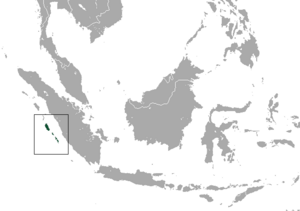Pig-tailed langur facts for kids
Quick facts for kids Pig-tailed langur |
|
|---|---|
 |
|
| X-ray image of the skull of a pig-tailed langur | |
| Conservation status | |
| Scientific classification | |
| Genus: |
Simias
|
| Species: |
concolor
|
 |
|
| Pig-tailed langur range | |
The pig-tailed langur (Simias concolor) is a large Old World monkey. It is the only species in its genus Simias. This monkey lives only on a few small islands near Sumatra in Indonesia.
It has a black face and black-brown fur. Its tail is quite short. The pig-tailed langur is active during the day. It eats leaves, fruits, and berries from the rainforest trees. Not much is known about its life in the wild. However, people hunt it a lot. Its numbers are quickly going down. Because of this, the International Union for Conservation of Nature says it is "critically endangered". It is also on a list of the World's 25 Most Endangered Primates.
Contents
About the Pig-Tailed Langur
The pig-tailed langur is an arboreal primate. This means it spends most of its time in trees. It mostly rests and eats. These monkeys live in groups with one male and several females. Group sizes can be from 3 to 9 monkeys. This depends on where they live and how much hunting happens.
There are two types of pig-tailed langurs:
- Simias concolor concolor: This type lives in the southern Mentawai Islands.
- Simias concolor siberu: This type lives only on the northern island of Siberut.
Male pig-tailed langurs are bigger and heavier than females. This is called Sexual dimorphism.
What Does the Pig-Tailed Langur Look Like?
The pig-tailed langur is a big, strong Old World monkey. It has long arms that help it climb well. Its fur is black-brown, and its face is black and hairless.
It is the only monkey in its group (called Colobinae) with a short tail. The tail is only about 15 centimeters (6 inches) long and has little fur. Its short nose points upwards. A full-grown pig-tailed langur is about 50 centimeters (20 inches) long. It weighs around 7 kilograms (15 pounds).
What Does the Pig-Tailed Langur Eat?
The pig-tailed langur is an omnivore. This means it eats both plants and some animals. Its diet mainly includes leaves, flowers, and fruits. Sometimes, it also eats insects. There is plenty of food for them in their habitat. They eat mostly leaves, followed by fruits. Like other monkeys in its group, the pig-tailed langur is active during the day.
Where Do Pig-Tailed Langurs Live?
This primate lives only in the Mentawai Islands. As mentioned, there are two types:
- Simias concolor concolor: Also called simasepsep. It lives on the southern islands of Sipora, North Pagai, and South Pagai.
- Simias concolor siberu: Also called simakobou. It lives only on the island of Siberut.
The pig-tailed langur is a daytime animal that lives in the arboreal rainforest. It usually stays in the trees. However, it sometimes comes down to the ground. These monkeys spend most of their time resting and eating. They spend less time traveling or playing with each other.
Group sizes can vary. Some studies on Siberut show small groups (about 2-3 monkeys). Other parts of Siberut have larger groups (around 8-9 monkeys). Scientists think that human activities like hunting and cutting down forests might cause these differences. Pig-tailed langurs live in groups with one male and many females.
Why Are Pig-Tailed Langurs Endangered?
The International Union for Conservation of Nature lists this species as critically endangered. It was listed as endangered until 2008. Then, its status changed to critically endangered. It is one of The World's 25 Most Endangered Primates.
The main reasons for this are human activities. These include:
- Cutting down forests for business.
- Hunting.
- Illegal pet trade.
Studies show that the number of pig-tailed langurs has dropped a lot. For example, in the 1980s, there were about 19,000 on Siberut island. By 2004, the total number across all islands was much lower. Areas where forests were cut down had fewer langurs.
Forest cover is very different across the islands. Most of Siberut island is a National park. This helps protect the forests. But the southern islands like Sipora, North Pagai, and South Pagai have very few protected areas.
Siberut's forest cover went down from 3,500 square kilometers to 2,400 square kilometers. The southern islands' forests dropped even more, from 1,300 square kilometers to 300 square kilometers. Conservation efforts started in the 1980s on Siberut. A large part of Siberut became a National Park in the 1990s. This helped reduce hunting and logging. However, some areas near the park still face threats.
The loss of forests in the southern islands leads to more human activity. This includes building settlements. The second big threat is hunting. Local people have hunted these monkeys for a long time. They used arrows and poisons. Now, with guns, hunting is easier. The pig-tailed langur is one of the largest monkeys on these islands. Many locals hunt it because they think its meat tastes the best. More hunting in an area means fewer langurs live there.
Subspecies
- Genus Simias
- Pig-tailed langur, Simias concolor
- Simias concolor concolor
- Simias concolor siberu
- Pig-tailed langur, Simias concolor


